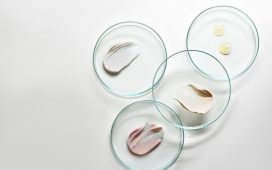When Liz Mason opened a cookbook from 1886, the last thing she expected was a recipe for turtle murder. And yet, between gallons of cream and lifestyle tips like how to remove your kidskin gloves, there was a description of concealing a “deadly weapon” with “great ingenuity”. “I have known half an hour to be consumed in the process,” wrote the recipe’s architect Anna Ella Carroll. The resulting dish, found in a chapter called “Fish, Oysters and Clams” is terrapin soup but “decidedly the terrapin has to be killed before cooking”.
“I can’t imagine putting terrapin on a menu in Sydney,” Mason reflects. But she seems slightly tempted. For the last six months, the executive chef has been experimenting with recipes from The Woman Suffrage Cookbook, originally compiled in Boston by Hattie A Burr, and a British book – The Women’s Suffrage Cookery Book – compiled by Aubrey Dowson and originally published in 1910. At the time, on both sides of the Atlantic, cookbooks were a popular form of propaganda for the cause, and featured recipes donated by women involved in the movement.

Song Kitchen is a profit-for-purpose enterprise that supports the YWCA, and Mason discovered suffragette cookery through a colleague at the Y. “As soon as I heard about it I knew I had to use them,” she says.
On March 7, Mason will be cooking eight suffragettes’ recipes for a group of 70 diners. It’s been a complicated endeavour. The recipes are far less detailed than the ones we’re used to reading, “you need to have an understanding of how to cook to interpret [them],” she explains. And then there are the measurements, “capfuls”, “loaves of sugar” – “trying to just buckle down what the measurements are has been a challenge”.
To add to the difficulty, her team will be making everything the old fashioned way – down to hand-churning butter. “You should have seen my sous-chef’s face when I told him to put the Kitchenaid away,” she says with a giggle. “Something that would take 10 minutes takes two hours.”
Some recipes the chef was initially sceptical of have proven fruitful, like a lettuce soup with a “super strange” method that involved sautéing endive, chicory and sorrel leaves in flour then blending them with cream. “Then we tasted it and it was mind-blowingly delicious. It’s really fragrant.”
The suffrage movement had its share of racism, but Mason has been surprised by how multicultural the cookbooks are, with clear influences from India, China and parts of Africa. Some dishes have called for Kashmiri chillies and other ingredients “I didn’t anticipate they’d have access to”.
Maize, cinnamon and nutmeg are common throughout both books – as is an abundance of cream. “Every recipe has bucketloads of cream or bucketloads of butter. We’re all very health-conscious now … but everything is either thickened with it, emulsified with it or flavoured with it.”
Because the flavours are often simple, and sometimes a little “one-dimensional”, Mason has had to work hard to find the best produce to execute the dishes. One attempt at lemon curd was let down by less-than-flavoursome lemons, “but when you were just picking it off the tree, it would have just tasted like proper lemon.”

Mason notes the tone of the suffragettes’ writing has been markedly different. There are dishes with names like “Rebel Soup” (tomato, flour and – you guessed it – lots of cream), and “Election Cake”; and “there’s a self-assured theme that runs through the writing. I’ve worked with other recipe books from that time and from earlier, and you don’t have that. It’s kind of second-guessing. This book is more like ‘You will do this, and it will be the best thing you’ve ever done.’”
The “ingenious” techniques the women used to get results are already carrying through to Mason’s regular work; like using gelatine to stop sorbet from separating. But, it’s the asides and suggestions for a life well lived that she most wishes she could find in modern cookbooks. “Now how will I know how to take off my kidskin gloves?”
• Song Kitchen’s International Women’s Day dinner will take place on 7 March in Sydney. A re-release of Mrs Aubrey Dowson’s The Women’s Suffrage Cookery Book from British Library Publishing will be available in Australia from 26 March
This article contains affiliate links, which means we may earn a small commission if a reader clicks through and makes a purchase. All our journalism is independent and is in no way influenced by any advertiser or commercial initiative. By clicking on an affiliate link, you accept that third-party cookies will be set. More information.













